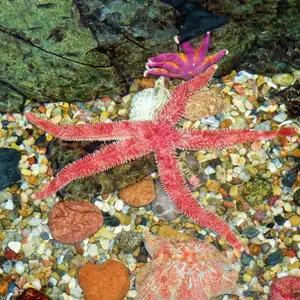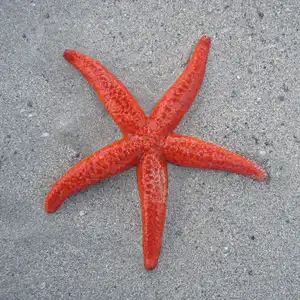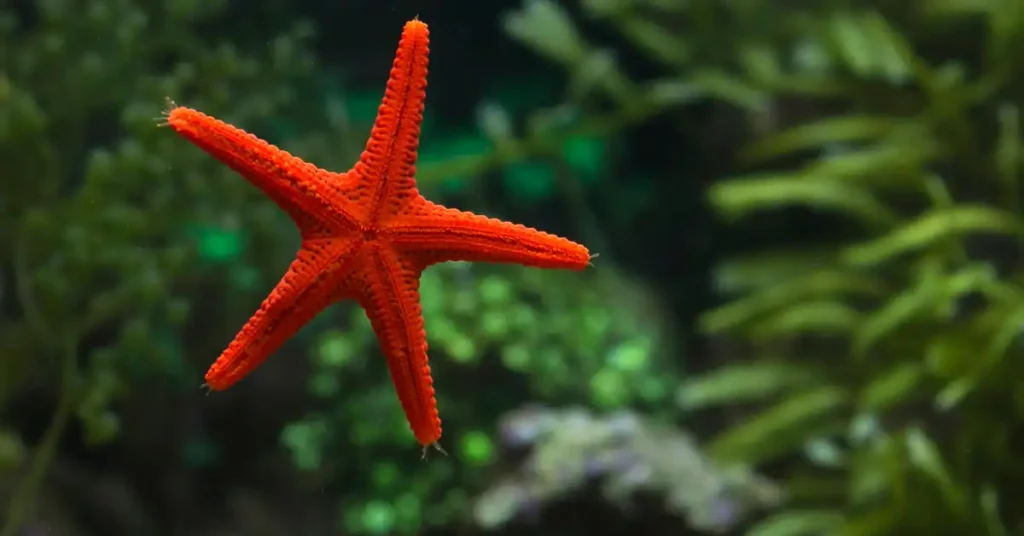The Fromia starfish is a unique and beautiful species that has been known to the aquarium hobby for quite some time. They are often called the Red, Orange, or Pink Formia starfish. They are not only known for their looks, but also for their relatively low maintenance and easy-to-care-for requirements.
They come in many different shapes, sizes, and colors. Common Names are Fromia Starfish, Red Starfish, Orange Starfish, Pink Starfish,white-spotted star, daisy sea star, red cushion star, and reef sea star. The Fromia Starfish is one of the most stunning species of starfish. Its color and dots can be found in several varieties, each one with a unique pattern. Fromia starfish is a genus of popular marine invertebrates. They are commonly referred to as the Fromia sea star or just the Fromia starfish.
Appearance
This starfish has the appearance of a heart, with the top being wider and then the bottom tapering off. The color of the Fromia starfish can vary from bright red to orange and can even be greenish yellow in some cases.
The body is covered with spines that are actually tube feet which are used for movement. There are also five rows of small white dots on their body which give them a beautiful appearance.
The Fromia Starfish is a marine invertebrate which looks like a starfish. It has a wide range of colors from red to green, blue and orange.Fromia starfish are beautiful primarily red starfish. Their bodies are almost entirely a bright red color, with the exception of the tips of their arms which are white or gray. They have a raised central disk that is also a bright red, and five legs with pointed tips.
Diet & Feeding Habits
The Fromia starfish stands out as one of the most beautiful starfish species, but it is also very rare in the ocean. So naturally, in captivity, it can be even more difficult to find.
Fromia Starfish are omnivorous and require a mixed diet. They feed on tiny plants, detritus, uneaten food, small invertebrates, sea cucumbers, and soft algae. When placed in a new aquarium, they will starve before any algae start growing in the tank. So it is important to feed them with commercial starfish food or other small invertebrates like Artemia nauplii, baby brine shrimp, or Daphnia.

Feed them only twice a week with smaller amounts of food than you normally do for your fishes. The main reason for this is that starfish cannot expel excess food from the body. Therefore it is easier for them to digest a smaller amount of food instead of a large one.
It is important that you feed them with varied foods so they can live longer. They will eat brine shrimp and frozen mysis shrimp. They will also eat flake food or pellet food but be sure to crush this before feeding it to them as they do not have teeth.
To feed a Fromia starfish in captivity, offer it food at least once per day. It won’t be able to eat everything you give it in one go, which is why it’s best to only offer small amounts at a time.
Habitat of Fromia Starfish
Fromia starfish are found in the Indo-Pacific region. They prefer shallow water, usually between 5 and 35 meters deep. They like to live on rocky and sandy bottoms, but they also can be found hiding under rocks or in coral crevices. They are also seen in parts of East Africa, the Red Sea and South East Asia. The Fromia Starfish prefers to live in sandy or muddy coastal waters.
They usually live in shallow waters near the coast, where they can find plenty of algae and other nutrients to feed on.
Because of this, you can often see them in tide pools and shallow streams. Fromia starfish also like to hide among the rocks, where they can ambush their prey.
The different fromia starfish species inhabit a wide range of marine habitats, including shallow lagoons, rocky shores and coral reefs. Some fromia species, such as Fromia elegans and F. monilis, are quite common in these areas and are often present in high densities. Other species are mostly rare and have very limited distributions. They can be seen singly or in small groups.
Reproduction & Growth
The reproduction of Fromia Starfish can happen in two ways, sexual and asexual. Sexual reproduction happens during the spawning season in colder waters. Male Fromia Starfish release sperm into the water that is then captured by the females. The female Fromia Starfish will then go into a brooding process where it will carry around the eggs until they hatch.
Asexual reproduction is just as simple, but it doesn’t require a male. Female Fromia Starfish can cut off their own arms to reproduce. The arm that was detached from its body will grow back by itself over time, but it still has all the DNA of the original starfish and can reproduce on its own.
Fromia starfish are gonochoric. During the breeding season, they release eggs or sperm into the water column. The eggs are fertilized externally and the larvae live in the plankton for a few days to several weeks before metamorphosing into juveniles. They then settle on the bottom and start feeding. As they grow, they molt by absorbing water, which causes them to split at one of their sutures. A new section is formed at each molt.
The growth of Fromia starfish is not well studied, but it has been suggested that they grow larger than comparable species due to a lack of predators in the warm waters of their native range. Generally the growth of Fromia starfish is determined by their food supply, temperature, environmental condition and other physical factors. Typically, as with other living organisms, the younger an organism is, the faster it grows. Growth rates may also be determined by how much food an organism ingests. The more food an organism eats, the larger and faster it will grow.
Predators & Defenses
Predators of the Fromia genus are fish, crabs, birds, and certain mammals. These animals like to eat starfish because they are easy to catch and they taste good. The most common predator is a sea bird that will come along and eat the Fromia starfish. However, it is important to note that there are very few predators who seek out Fromia starfish as their main food source. Most of them will be eaten on accident or when other food is not readily available.
Another predator of the Fromia starfish is humans. Humans like to eat all different types of sea life, and so the Fromia starfish will often be eaten by humans in certain parts of the world.
Fromia genus has excellent defenses against their most common predators.The first defense mechanism of the Fromia starfish is its hard shell. Also known as the “test,” this is a skeletal structure composed of calcium carbonate. The test forms a protective covering around the organs and muscles of the Fromia starfish.
The second defense mechanism of the Fromia starfish is its ability to regenerate, or regrow, lost portions of its body. When attacked by predators, such as crabs, the Fromia starfish can detach an arm and escape to safety. Then, it grows another arm to replace the missing one.
Fromia starfish are very vulnerable to predators. If they come across a predator, such as a crab or another sea creature, they will begin moving their arms rapidly in the opposite direction of the predator. This movement makes it harder for the predator to catch them. While they can’t move very quickly, fromia starfish are extremely flexible and efficient at navigating their environment.
Fromia Starfish- Aquarium Care & Tips
Fromia starfish are more active than some other species of sea star and will move around the aquarium looking for food. The Fromia starfish are brightly colored reef-safe starfish that will make a great addition to any reef tank. They are relatively easy to care for and will eat a variety of aquarium foods. This species is also well-known for its beauty and color, which makes them very popular with hobbyists.
The Fromia starfish is a rather hardy fish and does not require much maintenance. It can be kept in a saltwater tank with other sea creatures and corals. But it is important to know that a lot of starfish are toxic and may kill off your tank’s inhabitants. Therefore, you need to make sure that the Fromia starfish does not come in contact with any of your other fish or corals.
It is very easy to take care for the Fromia starfish, but you will need to provide them with the right environment, a clean tank and suitable food. If those requirements are met, you will enjoy this magnificent creature for years.

They need plenty of space to move in, so they don’t do well when kept singly in small tanks. Fromia starfish prefer bright lighting and a moderate water flow.
As a rule you should never put a Fromia Starfish in with other invertebrates such as crabs and shrimps. If you do, they will be eaten! As for fish it is best to avoid keeping them with any fish that nibble at rockwork or corals. This includes Tangs, Blennies, Gobies and Dottybacks. Also some very large or aggressive fish may attack the Fromia Starfish. These include Lionfish, Groupers and Puffers.
These sea stars are reef safe and will not harm corals or other invertebrates. However, they can be aggressive towards other members of their own species and will fight with each other if housed together. It’s best to keep only one fromia starfish per tank unless you have a huge aquarium.
Tank size
The Fromia starfish is a peaceful starfish and it is not particularly large at all. It will do well in aquariums that are at least 20 gallons (75L). The larger the aquarium, the better.
Water Flow:
They need good water flow. Aim for at least 10 times the size of the aquarium in turnover per hour (GPH). So for a 30 gallon aquarium, you would want at least a 300 GPH powerhead or canister filter.
Temperature
The temperature of the water should be kept between 74 – 78°F (24 – 26°C). If it does get too cold, make sure to warm the water back up immediately.
Lighting
They do not require much lighting and will do fine with normal aquarium lights. However, if you keep them in an aquarium with photosynthetic/zooxanthellate corals or other invertebrates, you’ll need to provide sufficient light for these animals.
Decoration and Substrate
Fromia starfish do not require any specific substrate type, but they will do well in a sand-based tank. They need sufficient space between the rocks to crawl through and find their food, though they will survive in a very crowded tank.
Titling and Maintenance
Fromia starfish don’t require much maintenance; only do a standard water change every week or so (depending on your bio load).
Different Types of Fromia starfish
Fromia, a genus of sea stars, are known as the most colorful species in the world. Their colors range from red to orange and even green. They vary in size from a few inches to almost three feet. There are many different species of Fromia starfish, including the Fromia indica, Fromia nodosa, Fromia monilis, and the Fromia milleporella. Some look similar and may be difficult to identify without prior knowledge.
The genus Fromia is one of the most popular and easy to keep genera in the sea star family. The most famous species within this genus is Fromia milleporella, a colorful species with a wide distribution along the subtropical and tropical regions of the Indo-Pacific. It is at home in coral reef areas as well as in rocky and sandy habitats, where it likes to bury itself in the substrate.
Fromia Nodosa
Fromia nodosa is a close relative of F. milleporella that is only found in the Red Sea and Gulf of Aden. It has a similar diet and can be kept under similar conditions, but its beautiful appearance makes it unique among Fromia species.
Fromia Monilis
Fromia monilis is often confused with F. nodosa because they look very similar when they are young. F. monilis, however, changes its coloration as it ages to become more orange-red than purple-red. It can also be distinguished by the presence of white spots on its aboral side that are absent from F. nodosa and other Fromia sea stars.
Fromia Indica
Fromia Indica is a stunningly beautiful sea star that has a thick, leathery body with bright red plates and arms tipped with white spines. It is one of the most sought after Fromia species, and is also known as the Elegant Starfish, Red Starfish, or Red Knob Sea Star.
Interesting Facts
- Fromia Starfish is one of the most famous pet starfish. This species is well known for its colorful and beautiful appearance.
- Fromia Starfish is a pretty, popular and easy-to-keep species of sea stars.
- The Fromia Starfish is often seen as a beginner’s sea star. They are beautiful, hardy and relatively simple to care for. They are a medium sized species of starfish and are generally quite hardy making them an ideal choice for beginners or children.
- With its elegant and simple design, it makes for an excellent addition to any reef tank. There are many different types of starfish available for the home aquarium. The Fromia Starfish is one of the most popular species available.
- The five legs are long and thin. Each one is covered in numerous small spines, which end in a small point. Each leg also features two rows of tiny tube feet that they use to get around the ocean floor.
- Fromia Starfish have six arms that can reach up to 20cm in length, these arms are covered in small white dots. They have an oral disc (mouth) which is situated on their underside which they use to absorb their food using tube feet.
- The Fromia is also known as the Red-Knobbed Starfish or Red Sea Star, due to its distinctive red knobs on the end of each arm. The Fromia Starfish comes in a variety of different colorations, including red, orange, green, blue, purple and pink.
- They may have a lighter colored stomach which may contrast dramatically with the rest of the body or they may be uniform in color all over. The tips of their rays will always be a different color than the rest of their body though.
Fromia Starfish- Related FAQs
Are Fromia starfish reef safe?
Fromia starfish are very reef safe. This group of starfish is not known for eating corals or sessile invertebrates because of the way they feed. Fromia starfish filter the water column for plankton and other organic material to consume. They tend to feed at night and will retract their legs under their body. In the morning, you can see them with their arms outstretched again as they take in oxygen from the water.
How long do Fromia starfish live?
The lifespan of a Fromia starfish is roughly five years. The oldest ever recorded in the wild was 9.5 years old. But the Fromia starfish is a slow-moving, reef-dwelling creature that can live up to 10-20 years in a home aquarium.This varies depending on diet, habitat, predators and other environmental factors.
Are Fromia starfish hard to keep?
The answer is no. Fromia starfish are easy to keep. They are peaceful, reef safe and even dead they are beautiful. Which makes them a perfect addition for any reef tank!
Fromia starfish are fairly hardy and easy to care for.These starfish are very easy to keep and don’t need any special attention.
Are Fromia starfish poisonous?
Fromia starfish are not poisonous, but they do have venom. The only way to encounter their venom is to touch them and this will result in a painful sting that can be pretty severe depending on how sensitive your skin is.
This is usually followed by swelling and inflammation of the affected area for about 24 hours, and in some cases, it can even turn red or purple. However, it’s not at all lethal, and these side effects will only last for a short time.
Conclusion
Fromia Starfish is the best saltwater aquarium fish. Most delicate and sensual fish on the world. It is believed that keeping Fromia Starfish in a saltwater aquarium will bring good luck and will protect the owner from evil. They are one of the most popular sold fishes in Indonesia, where they are often called lucky fish.
The Fromia Starfish is the most beautiful starfish. Their great colors, patterns and variety will make all aquarists admire them.
